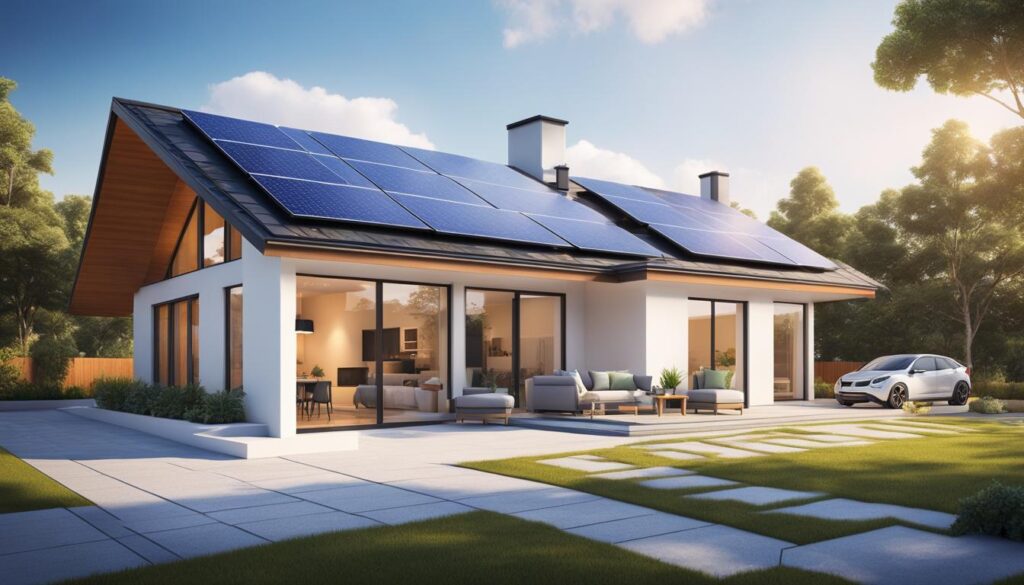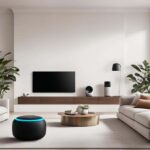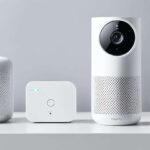As I looked at my hefty energy bills every month, I realized it was time to take control of my energy consumption. That’s when I started exploring smart energy-saving strategies for my home. I discovered that implementing these strategies not only helped me reduce my bills but also enhanced the efficiency of my appliances.
If you’re just starting out on your energy-saving journey like me, don’t worry! There are plenty of beginner-friendly strategies that you can easily implement in your home. By making some small changes, you can make a big impact. Let’s dive into some smart home strategies that can help you reduce your bills and enhance your home’s efficiency.
Table of Contents
Key Takeaways:
- Implementing smart energy-saving strategies can help beginners reduce their bills and enhance the efficiency of their appliances.
- A smart home starts with small changes, such as using energy-efficient light bulbs and unplugging electronics when not in use.
- Investing in a smart thermostat can optimize energy usage in your home.
Understanding Energy Consumption in Your Home
Before you can effectively save energy in your home, it’s important to understand how energy is being consumed. Appliances and electronics left on standby mode can still draw power, contributing to unnecessary energy usage.
According to my research, appliances and electronics in standby mode can consume up to 10% of their total energy consumption. For example, a television left on standby mode can still use around 5-10 watts of energy per hour.
To reduce standby power consumption, it is recommended to unplug electronics when not in use. This can be as easy as unplugging chargers, gaming consoles, or audio devices when they are not actively in use. Utilizing power strips with on/off switches can make this process even more convenient.
- Remember to turn off and unplug appliances and electronics when you’re done using them.
- Consider investing in smart power strips that automatically shut off power to devices in standby mode.
- Utilize power-saving modes on electronics such as computers and game consoles.
In addition to standby mode, understanding the energy labels on appliances can help you choose the most energy-efficient options when purchasing new ones.
Energy labels, provided by organizations like ENERGY STAR, provide valuable information about the energy consumption and efficiency of appliances. When shopping for new appliances, look for those with the highest energy efficiency ratings to minimize energy consumption.
To further illustrate the importance of unplugging electronics and choosing energy-efficient appliances, here’s a table comparing energy consumption and standby power usage of common household electronics:
Comparison of Energy Consumption and Standby Power Usage
| Appliance/Electronic | Energy Consumption per Hour (watts) | Standby Power Usage per Hour (watts) |
|---|---|---|
| Television | 100-400 | 5-10 |
| Computer | 80-150 | 2-6 |
| Coffee Maker | 800-1,500 | 1-2 |
| Game Console | 50-150 | 2-4 |
| Phone Charger | 1-5 | 0.1-0.5 |
Implementing Energy-Efficient Lighting
Lighting plays a significant role in the energy consumption of a home. By implementing energy-efficient lighting solutions, you can not only save energy but also reduce your electricity bills. Let’s explore some strategies for incorporating energy-efficient lighting into your home.
1. Replace Traditional Bulbs with LED Bulbs
One effective way to save energy is by replacing traditional incandescent bulbs with energy-efficient LED bulbs. LED bulbs use significantly less energy and have a longer lifespan, making them a cost-effective solution in the long run. According to one study, LED bulbs can save up to 80% more energy compared to traditional bulbs.
2. Maximize Natural Light
Another way to reduce energy consumption is by maximizing the use of natural light during the day. By opening curtains or blinds, you can let in natural light, which not only brightens up your home but also reduces the need for artificial lighting. This simple step can have a significant impact on your overall energy usage.
3. Install Dimmer Switches
Installing dimmer switches is a smart way to adjust the brightness of your lights and save energy. Dimming your lights can significantly reduce electricity consumption, especially in rooms where bright lighting may not be necessary at all times. With dimmer switches, you have the flexibility to create the perfect ambiance while conserving energy.
“Using LED bulbs can save up to 80% more energy compared to traditional incandescent bulbs.”
By implementing these energy-efficient lighting strategies, you can not only contribute to a greener environment but also enjoy long-term energy savings.
| Benefits of Energy-Efficient Lighting | Traditional Incandescent Bulbs | LED Bulbs |
|---|---|---|
| Energy Savings | High energy consumption | Up to 80% energy savings compared to traditional bulbs |
| Lifespan | Short lifespan | Longer lifespan, reducing replacement frequency |
| Environmental Impact | Higher carbon footprint | Lower carbon footprint, reduced greenhouse gas emissions |
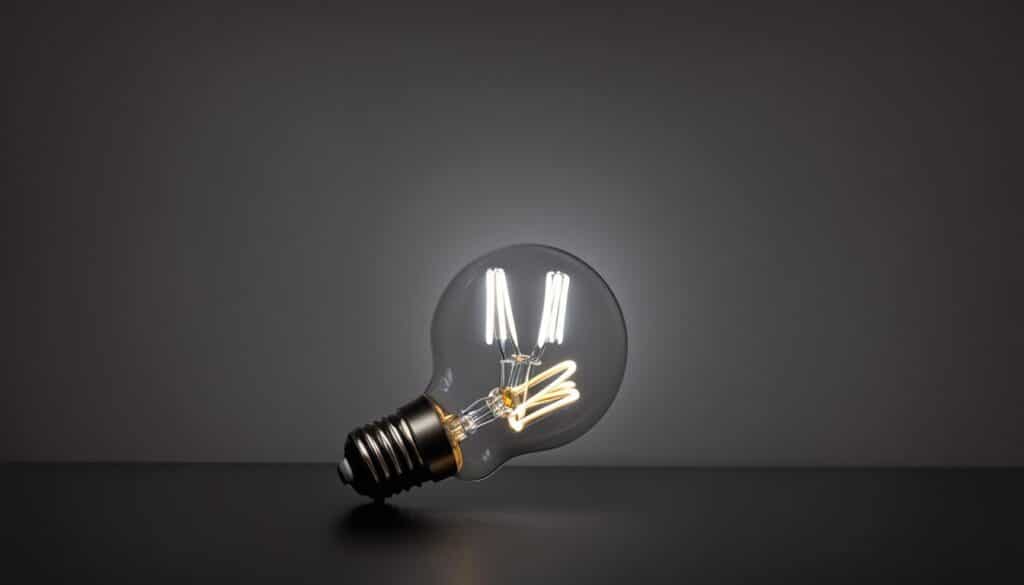
As you can see from the comparison table, LED bulbs offer significant advantages over traditional incandescent bulbs in terms of energy savings, lifespan, and environmental impact.
Next, let’s explore strategies for effectively managing heating and cooling systems in our homes to further enhance energy efficiency.
Managing Heating and Cooling Systems
Heating and cooling systems play a significant role in our energy consumption. Whether it’s keeping our homes warm during the winter or cool during the summer, these systems can consume a substantial amount of energy. To optimize energy usage and reduce costs, it’s important to implement smart strategies for managing our heating and cooling systems.
One of the key ways to optimize energy usage is by using a programmable thermostat or investing in a smart thermostat. These devices allow you to set temperature schedules based on your daily routines, ensuring that your heating and cooling systems are not running unnecessarily when no one is home. By adjusting the temperature settings automatically, you can save energy without compromising comfort. Additionally, smart thermostats often come with features that allow you to control the temperature remotely through your smartphone, ensuring that your home is always comfortable when you arrive.
Regular maintenance is another crucial aspect of managing heating and cooling systems. This includes replacing air filters regularly to ensure efficient operation. Clogged filters can restrict airflow, forcing the system to work harder and consume more energy. By keeping the filters clean, you can enhance the efficiency of your heating and cooling systems, reducing unnecessary energy consumption.
“Regular maintenance is essential for ensuring that your heating and cooling systems operate efficiently. Replacing air filters regularly is a simple yet effective way to optimize energy usage.”
In addition to thermostat optimization and regular maintenance, insulation plays a vital role in energy efficiency. Insulating your home effectively reduces heat loss during the winter and heat gain during the summer. By preventing air leaks and maintaining a well-insulated space, you can reduce the strain on your heating and cooling systems, leading to significant energy savings.
“Insulation is a powerful tool for reducing energy consumption in your home. Proper insulation helps maintain a comfortable temperature and reduces the workload on your heating and cooling systems.”
Benefits of Managing Heating and Cooling Systems
| Benefits | Description |
|---|---|
| Energy savings | Optimizing temperature settings and maintaining efficient operation can lead to reduced energy consumption and lower utility bills. |
| Improved comfort | A well-regulated indoor temperature ensures a more comfortable living environment. |
| Extended equipment lifespan | Efficient operation and proper maintenance can prolong the lifespan of your heating and cooling systems, saving you from expensive replacements. |
| Environmental impact | Reduced energy consumption helps minimize carbon emissions and promote a greener lifestyle. |
By implementing these strategies for managing heating and cooling systems, you can not only reduce energy consumption and lower your utility bills but also contribute to a more sustainable future. Take control of your home’s temperature and make a positive impact on both your wallet and the environment.
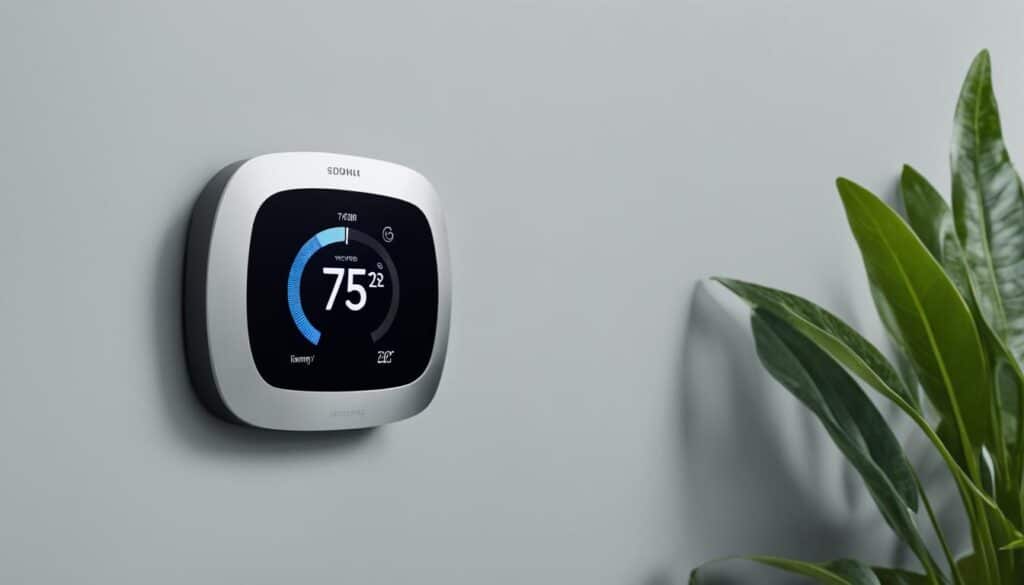
Conclusion
Implementing smart energy saving strategies in your home can have a significant impact on reducing your bills and enhancing the efficiency of your appliances. By understanding energy consumption, implementing energy-efficient lighting, and managing your heating and cooling systems, you can take the first step towards creating a more energy-efficient home.
Beginners can start their energy-saving journey by making small changes such as switching to energy-efficient light bulbs and unplugging electronics when they’re not in use. Investing in a smart thermostat can also optimize energy usage based on your schedule and preferences.
By implementing these beginner strategies, you can reduce your energy bills while also contributing to a more sustainable future. So why wait? Start making these changes today and experience the positive impact on both your energy savings and environmental footprint.
FAQ
How can implementing smart energy saving strategies in my home help me reduce my bills and enhance the efficiency of my appliances?
According to experts, implementing smart energy saving strategies can help you reduce your bills by optimizing energy usage and enhancing the efficiency of your appliances. By making small changes such as switching to energy-efficient light bulbs and unplugging electronics when not in use, you can start saving energy and seeing a positive impact on your bills.
Why is it important to understand how energy is being consumed in my home?
Understanding how energy is being consumed in your home is crucial because it allows you to identify areas where energy is being wasted. By knowing which appliances and electronics are drawing power on standby mode and being aware of energy labels on appliances, you can make informed choices and reduce unnecessary energy usage.
How can I reduce energy consumption related to lighting in my home?
There are several ways you can reduce energy consumption related to lighting in your home. Experts recommend replacing traditional incandescent bulbs with energy-efficient LED bulbs, maximizing the use of natural light during the day by opening curtains or blinds, and installing dimmer switches to adjust the brightness of lights and save energy.
What are some strategies for managing heating and cooling systems to save energy?
To save energy with your heating and cooling systems, experts suggest using a programmable thermostat or investing in a smart thermostat to optimize energy usage based on your schedule and preferences. Regular maintenance and replacing air filters are also important to ensure efficient operation. Additionally, insulation plays a significant role in preventing heat loss during winter and heat gain during summer.
What are some beginner strategies I can start implementing today to save energy in my home?
As a beginner, you can start by implementing energy-efficient lighting, understanding energy consumption, and managing your heating and cooling systems. By making these changes, you can take the first step towards a more energy-efficient home, reducing your bills and enhancing the efficiency of your appliances.
